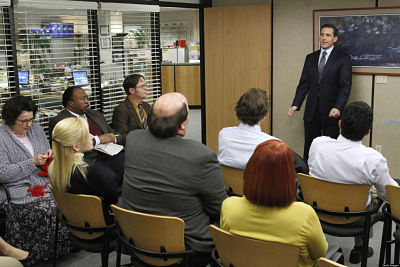Since taking on more administrative work this semester, I’ve found myself in many more meetings. Maybe this is why they call administration the “dark side?” Meetings can be great opportunities to make decisions, share perspectives, and move a project forward. Yet, too frequently, they are an opportunity to show up late, get nothing done (other than checking some email), and walk out knowing that is an hour or two that you’re never going to get back again. In today’s post, I share 6 tips that will help you lead more successful meetings.

I love the television show The Office. The show was never better than when Michael Scott called a conference room meeting. All of the employees knew they were going to lose the next hour or two getting nothing accomplished.
For many faculty (heck, for most people), meetings are a complete waste of time and money. Think about the sheer total salaries of the people sitting around the room the last time you were in a useless meeting. A bad meeting can waste literally thousands of dollars in terms of salaries.
But the good news is that meetings can be more effective. Follow these 6 tips for leading successful meetings to get more out of your next conference room session.
1. Start and end on time. You have to start and end your meetings on time. Starting late penalizes those that were on time by rewarding the tardy attendees. You inadvertently start to establish a culture where deadlines and time don’t matter. Ending late is equally problematic. People end up leaving early and everyone becomes distracted thinking about what they need to be doing next. Set firm meeting time boundaries and stick to them— no matter what.
2. Have an agenda. I once had a senior colleague that refused to attend any meeting without an agenda. It was a great rule. If the meeting wasn’t important enough to have an agenda sent out ahead of time, the meeting wasn’t worth his time. When you’re leading a meeting, the agenda is not simply a list of what is to be discussed. The agenda prioritizes topics and sets the amount of time to explore each topic. Sending an agenda at least 2 days before a meeting lets participants know what will be discussed and gives them time to prepare.
3. At the outset, state the goals for the meeting. As the leader of the meeting, you should know what the goal for the meeting is and share this with the group at the start. This helps everyone know the purpose of the meeting and what you’re hoping to achieve.
4. Actively guide the discussions. Meeting discussions can lag and get bogged down on irrelevant points. In addition, a discussion can focus on small points less suited to a large discussion. As the meeting leader and facilitator, ask clarifying questions and help focus the discussion. Offer to take up a point outside of the meeting or explain that the idea is important but not germane to the topic at hand. The goal is to reaffirm the person and their ideas, but not let the meeting get sidetracked.
5. Clarify action items. Often, meeting participants have action items to complete prior to the next meeting. Before ending a meeting, clearly identify what needs to be completed, who is responsible, and the deadline. I also suggest following up with participants to reiterate the action items as well as sharing these with the agenda for a follow up meeting.
6. Schedule the next meeting. If at all possible, schedule the next meeting. This will be difficult if everyone is not present at the meeting, but in that case at least identify a couple of possible meeting times and ask participants to hold the time in their schedule. One of the most frustrating parts about leading a meeting is getting it scheduled. Everyone is busy and has a lot going on. If you can nail down the next meeting time when people are in the room, it can save numerous emails and other correspondence in between meetings which saves time for everyone.
Running a successful meeting is difficult and you just have to keep working on it. Moreover, I encourage you to ask yourself if a physical meeting is even necessary. There are many times when I think that a meeting could have been done via memo rather than getting everyone together.
As you lead your next committee or meeting, I hope you find these tips helpful. And remember, just keep working on it. You won’t be able to get all of this right every time, but I do believe these tips for leading successful meetings will make you a better leader and manager.

